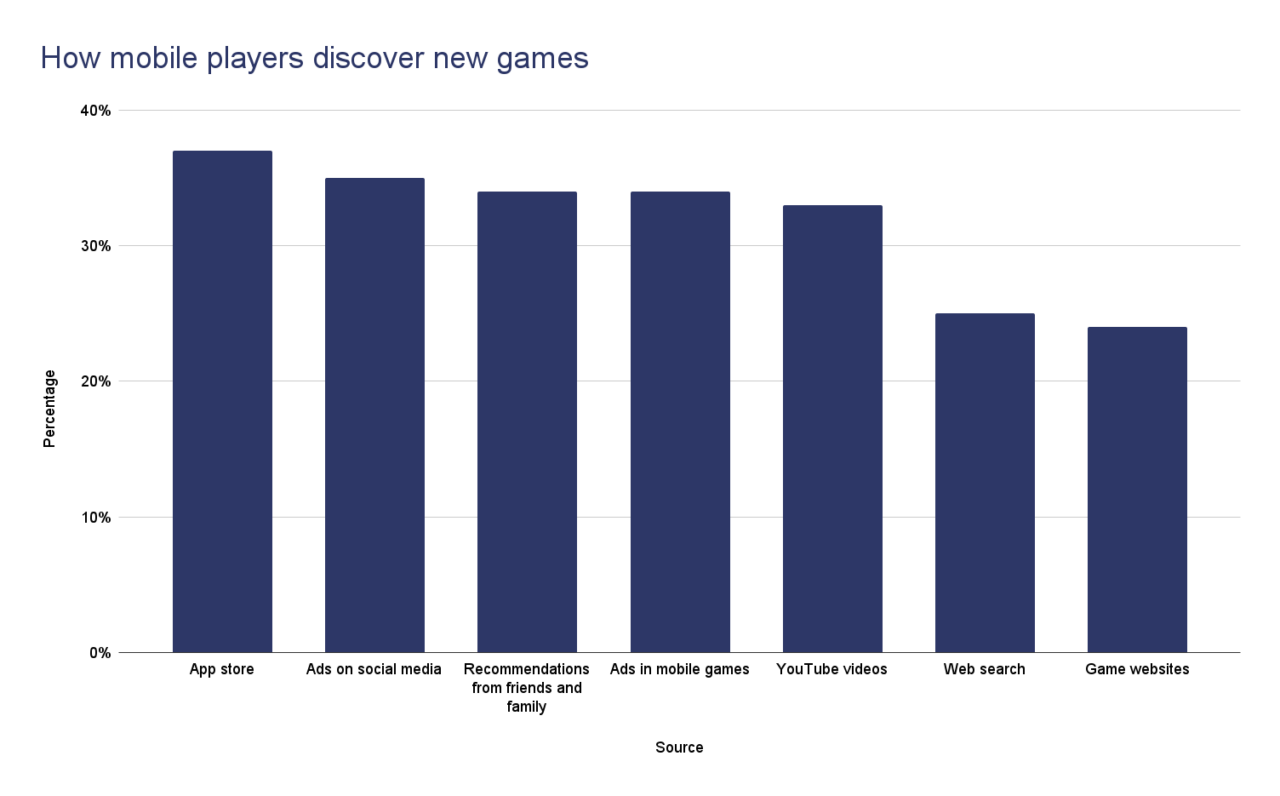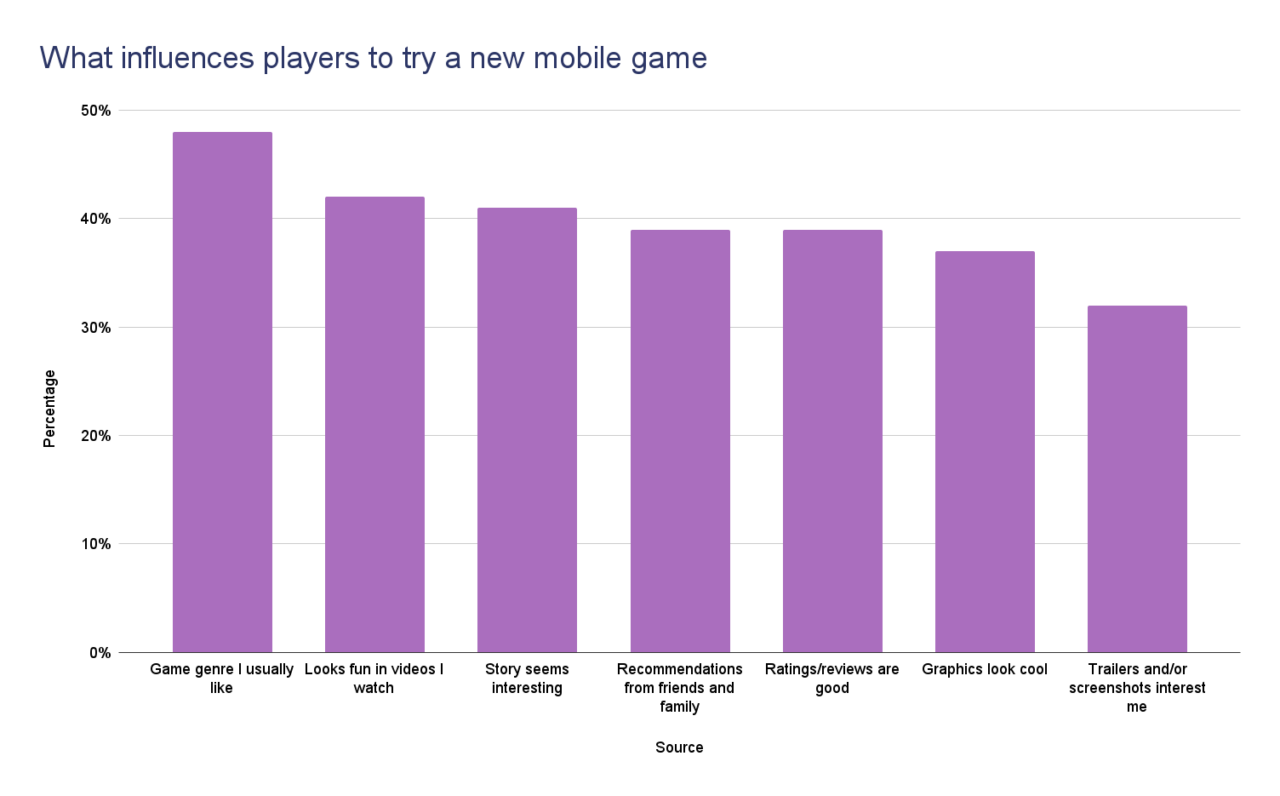In this blog post, we go through some of the most important industry trends and research findings so you can plan your user acquisition strategy for the latter part of 2022 and beyond with confidence.
With more and more mobile games and apps becoming available every year, it’s also getting harder and more expensive for new games to be discovered. In 2021 alone, over 2 million new apps were published and the global mobile app install ad spend is predicted to hit over 118 billion USD by the end of 2022.
User acquisition budgets are currently at record levels, so it’s increasingly important to understand what motivates players to try new games, where they discover them, and who they turn to for information.
If you develop an in-depth understanding of these aspects, it is much easier to develop a user acquisition strategy that is future-proof – no matter how the advertising industry changes or if new tracking restrictions are introduced for example.
So let’s start from how discovery is currently happening.
Where does discovery happen?
Google offers excellent research insights into how people discover mobile games. They recently released the 2022 Mobile Insights Report, which interviews over 20,000 people and sheds light on the latest discovery behaviors.
The top five touch points where discovery for mobile games happens are: App stores (iOS and Android), social media ads, ads in mobile games, and YouTube videos. The top five are fairly close to each other at 37-33% respectively, but they have a significant lead on the next most popular ones: web search (25%) and game websites (24%), followed by a few other sources at much smaller percentages.

Source data: https://games.withgoogle.com/reports/2022-mobile-insights-report/ (How do mobile players discover new or upcoming games?)
Research from Data.ai also sheds light on which game categories are growing the fastest. Hypercasual games (in action, puzzle and simulation genres) had the most downloads by far in 2021, cumulatively reaching over 10 billion downloads. They are also growing the fastest.
This has two main implications:
- If you are developing or promoting a hypercasual title in these genres, you can potentially gain the most downloads. You will also have by far the most competition. Therefore it makes sense to try to discover and scale new marketing channels and mediums (where competition might be less intensive) as much as possible.
- It might be easier to generate meaningful revenue in other genres and categories, but no category lacks strong competition. You still need to stand out.
However, install growth does not necessarily equal in-app revenue growth. According to Deconstructor of Fun, while hypercasual games increased revenue by a respectable 26% in 2021, the fastest revenue growth (+42%) actually came from the tabletop games genre.
Interestingly they also found that the market seemed to become more top-heavy in 2021. 65% of all in-app purchase revenue went to the top 100 most popular games. This puts further pressure on discovery efforts for new games.
But which mediums actually convince people to take the critical step to install the game and try it out?
What actually influences trying a game out?
In Google’s research, the most popular reason was not surprising: 48% of players try new games because they are in a genre the players already like.
But the second and fourth most popular reasons are particularly interesting: 42% of people try a game because it looks fun in videos they watch and 39% do it because of recommendations from friends or family. In other studies, it has been found that followers of particular YouTube creators can see them as friends, so they could be counted among this group as well.
The reasons listed by Google at above 30% were the following:

Source data: https://games.withgoogle.com/reports/2022-mobile-insights-report/ (What influences mobile players to try out new games?)
Meta (Facebook) has also researched mobile gaming behaviors. Their latest report from 2021 found that at least some level of familiarity with a game is very important for trying it out. Depending on the market, only a quarter or less of gamers are willing to try a game they’ve never heard of before. This means that building familiriaty with your title is an important part of a successful user acquisition strategy.
It turns out the monetization method matters as well. The most preferred monetization method among players was a free-to-play, ad-supported model (preferred by over a third of the respondents), followed by the free-to-play, in-app purchase model and the game purchase without ads model (at much lower percentages).
Meta also found that in terms of ad elements, seeing the core gameplay was the most important to players by a significant margin (e.g. 46% of existing US gamers found this the most important) – followed by showing the characters/story and art style respectively.
Findings from Unity (whose platform already powers over 50% of all mobile games) also support this as they have found that expectations for better graphics are growing even in the mobile gaming space – not just with AAA console and PC titles. So if your game has great graphics and a personal art style, it makes sense to highlight these aspects when promoting your game.

What are the implications?
Based on these findings from different research, here are a few things we recommend.
1. Drive discovery with YouTube and other social channels and encourage recommendations
If potential players are unfamiliar with your game (at least on a basic level), they are much less likely to install it! YouTube videos drive discovery extremely effectively for audiences interested in mobile gaming.
Make sure you share material on your own channel and work with creators to spread the message about your game (more on this in point 3).
This can be enhanced further by ads in YouTube, Facebook, Instagram, TikTok and other platforms, but the best effect will be reached by leveraging organic content together with paid advertising.
You should also aim to make recommendations as easy as possible. Encourage people to leave reviews in the app stores and reward players (and their friend) if they invite a friend to the game.
2. Encourage people to try your game by highlighting important factors in ad creative and copy
When it comes to ad creative and other messaging (such as creator sponsorships), make sure your ad creative and copy highlight things that are meaningful to players. The following aspects are extremely useful to showcase:
- Monetization method (especially if free-to-play)
- Reviews (especially if your review score is very good)
- Graphics and art style (especially if they are very polished or unique)
- What the story is about and who are the main characters
In terms of ad creative, video tends to perform best, and it is usually a good idea to include actual gameplay footage – not just stylized animated mockups, story videos, and similar things.
Although these are helpful benchmarks to get you started, nothing beats rigorous testing that helps you understand what performs for your game more specifically. You can find more information about A/B testing in creator marketing from our previous blog post for example.

3. Leverage YouTube creators and explore new marketing channels
Gaming creators are one of the best mediums available to get your game discovered because they match several of the top ways and reasons people discover and try new mobile games.
- They have highly engaged audiences that are interested in gaming and are thus highly likely to find your product interesting.
- Their content can serve as a strong recommendation to highly engaged viewers (especially when working with small- and midsize creators)
- They can easily show real gameplay footage and highlight factors that people might find interesting about your game. They do this in a highly authentic way, which is often more powerful than ads.
- The very big celebrity creators already do a lot of sponsorships with mobile games, but there is an enormous amount of small- and midsize gaming channels that remains largely untapped (by you and your competitors). In the aggregate, these creators have enormous reach and can be much more cost-effective than the big stars.
Working with a high number of creators can be resource intensive. Matchmade can help you work with them at scale in an automated manner so you do not need massive internal resources for managing them.
Testing other new, emerging marketing channels can also be worth it. Whenever there are new, interesting ones available, consider investing at least a small test budget in them to see if they can become a recurring part of your user acquisition strategy.
This might help you avoid the more intense competition on the more established channels. It also helps you get the learnings early on if the channel ends up becoming popular for potential players.
Conclusion
Although the mobile gaming landscape is becoming more and more competitive, there are several ways to stand out from the crowd and get discovered.
By ensuring your user acquisition strategy contains the right kind of creatives, marketing channels and mediums, you can be confident about standing out in this crowded market in 2022 and beyond.
If you are interested in finding out more about how creator marketing can help your mobile game succeed, don’t hesitate to reach out.




